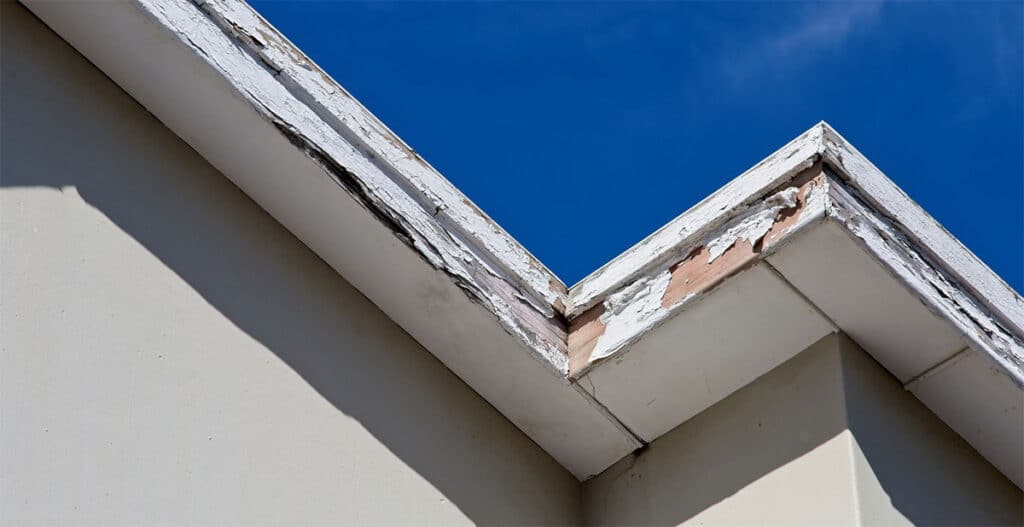The Step-by-Step Guide for a Roof Drip Edge Repair or Replacement
What is a roof drip edge?
A roof drip edge is a metal strip located at the edge of a roof. Its main job is to guide water away from the roof and into the gutters. This helps prevent water from soaking into the fascia, roof deck, and soffit. If a home needs a new roof, the drip edge should also be replaced to maintain proper protection.
Importance of a Roof’s Drip Edge
The roof drip edge plays several important roles:
- Water Management: It directs rainwater away from the roof and into gutters, stopping pools of water from forming.
- Fascia Protection: By moving water away from the fascia board, it helps evade moisture problems such as rot or damage.
- Soffit and Deck Defense: A well-placed drip edge shields the soffit and roof deck from water damage and mold.
- Aesthetic Value: It offers a neat finish to the roofline, improving the home’s outside appearance.
- Increased Lifespan: Preventing water-related damage helps the roof system last longer and reduces repair needs.
- Gutter Efficiency: A sound drip edge ensures water flows properly into gutters, keeping them functioning well.
- Ice Dam Prevention: In colder weather, it helps prevent ice dams from forming by keeping water flowing away from the roof edge.
Signs of Roof Drip Edge Damage
Homeowners should be aware of signs indicating a drip edge may be failing:
- Water Stains: Dark spots on the fascia or walls could result from water getting behind the drip edge.
- Peeling Paint: Flaking or bubbling paint near the roof line may suggest moisture is entering from a faulty drip edge.
- Rotting Fascia Board: Damage to the fascia close to the roof edge might indicate too much moisture exposure due to a bad drip edge.
- Mold or Mildew: Discovering mold growth around the roof edge suggests that excess moisture is being allowed inside.
- Water Dripping Behind Gutters: If water drips behind gutters, there could be an alignment issue between the gutter and the drip edge.
- Damaged Shingles: Shingles that curl or crack near the edge of the roof might be suffering from water infiltration.
- Ice Dams: Ice accumulation on the roof suggests problems with the drip edge that leads to water build-up and freezing.

Installation or Replacement of a Roof Drip Edge
When it comes to adding or replacing a drip edge, here’s the process typically followed:
- Assessment: The first step is to examine the current drip edge to identify any rust, corrosion, or detachment.
- Preparation: Before starting, the work area is set up to ensure safety and accessibility.
- Removal: The old drip edge is taken off carefully to minimize damage to the underlying materials.
- Clean-up: After removal, the area is cleaned to eliminate debris and prepare for the new installation.
- Measurement: Accurate measurements are taken along the roof edge to determine how much new drip edge is needed.
- Cutting (if required): The new material may need to be cut to the right length for a good fit.
- Installation: The new drip edge is fastened securely to the roof line to ensure it stays in place.
- Sealing: A high-quality sealant is applied along the top of the drip edge to protect against leaks.
- Finishing: After installation, the work is inspected to ensure everything is done correctly and looks good.
- Inspection: A final review ensures the installation meets quality standards for effectiveness.
- Maintenance: Guidance is provided on how to care for the drip edge to keep it functioning well over time.
This process ensures that the drip edge serves its purpose effectively while enhancing the longevity of the roof system.
Frequently Asked Questions
How is drip edge flashing installed on a new roof?
To install drip edge flashing on a new roof, start by placing the flashing along the eaves. It should be positioned so that it hangs over the edge of the roof. Secure it with roofing nails every 12 inches and ensure it is under the shingles for proper water flow.
What are the steps to replace drip edge on an existing roof?
Replacing drip edge on an existing roof involves a few steps. First, remove the old drip edge by prying it off with a flat bar. Next, clean the area where it was attached. Then, fit the new drip edge in place, ensuring it overlaps the shingles and secures it with nails.
What is the proper way to overlap drip edges to ensure water runoff?
To ensure water runoff, the drip edges should overlap by at least 1 inch. Place the top edge of the new piece under the previous one. This setup helps direct the water away from the roof and into the gutters.
What is the difference between rake edge and drip edge in roofing?
The rake edge runs along the sloped sides of the roof, while the drip edge is at the lower edge, where the roof meets the gutters. Both serve to protect the roof, but they are used in different locations and for slightly different purposes.
Is it possible to replace only the drip edge without installing a new roof?
Yes, it is possible to replace only the drip edge without needing a whole new roof. This repair can be done when the existing roof is still in good condition, ensuring continued protection from water damage.
How much does it typically cost to replace drip edge flashing?
The cost to replace drip edge flashing generally ranges from $1 to $2 per linear foot. Labor costs may add an additional amount, depending on the roofing contractor and the complexity of the job.






